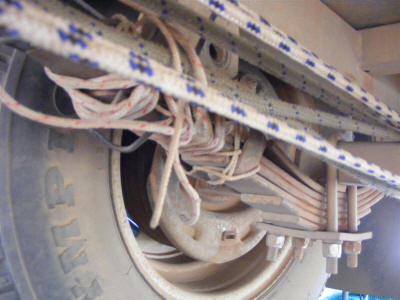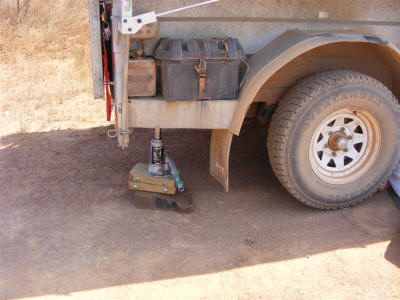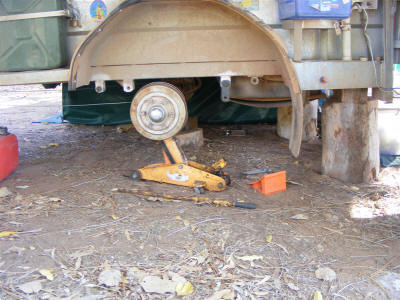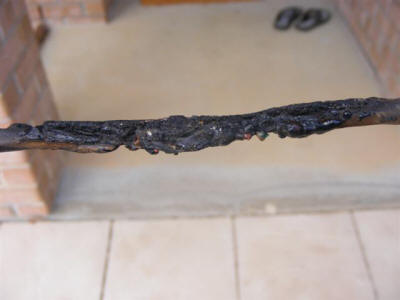Planning a long trip which included some rough roads, we
took the camper trailer to the local trailer shop and asked them to give it
a big service. So on that occasion they did the following:
* Moved the springs forward to better balance the trailer
* Replaced all shackle pins, shackles and Ubolts securing the axle
* Remarked that the springs were shorter than they normally use
* Adjusted the brakes
* Replaced and greased the bearings.
Satisfied that the trailer was prepared we set off on a trip to the gulf.
2925 kilometres from home and 1km from the turnoff into our destination we
had the misfortune to break a spring on the trailer. Now before you suggest
we were travelling to fast for the road conditions it took 3 hours to cover
99 kilometres and we were passed by other vehicles without trailers. So we
put the break down to plain old age as the spring had seen 40,000 kilometres
plus of roads with lots of dirt including all of Cape York.
Problem 1. How to
get mobile to somewhere suitable for repairs
The advice offered by other tourists was to lash the
spring together with wire. Then haul the axle forward on that side to about
its correct position with some more wire and then proceed slowly to the
station 30 kilometres away.
A When the spring broke it allowed the axle to move back
until the spring hanger touched the chassis. So the trailer needs to be
jacked up so that the axle can be allowed to move forward.
B The only wire available was high tensile fencing wire
and for those not familiar with the product it has all the properties of a
flat spring. You can wrap it around anything but the moment you release the
tension on it bingo it straightens out no matter how many rude words you
call it.
C Having given up on the wire I resorted to blind cord to
tie the spring together and several lashings of rope to try and hold the
spring forward.

A quiet drive of just over 2 hours and 30 kilometres down the road we had
reached our destination with all the modern conveniences like running water,
flushing toilets, hot showers and best of all a phone to the outside world.
Problem 2 How to
get a new spring
Tried the nearest town and yes he had a spring that would probably work so
7.5 hour round trip for 160 kilometres and we have two new springs. When
installed they were too long and immediately folded the shackles back up
against the chassis
We knew all the bits in the trailer came from Active
Fabrication in Brisbane so rang them and ordered two of the right size. It
will be a week so into holiday mode relax, swim, fish in the billabong. No
fish caught but I nearly caught a fresh water croc.
Another 7.5 hour trip to collect the new ones and the
trailer is sitting nice and high on her new springs. I couldnít get over the
difference in the shape as it has a lot more curve than the old one. No
wonder the old one broke as it must have flattened out. Now there was a
delusion.
Next morning all packed up we departed. Three kilometres out one of the new ones
folded the shackle back against the chassis so a u turn back to the
homestead to put in the original good spring. Five hours for 130 kilometres
and we are back on the bitumen albeit with the trailer 120mm higher on one
side.
Now the
observations for the future
1 The new ďcorrect sizeĒ springs were nothing like the old. We believe
Active Fabrication changed their supplier from 10 years ago so what they
sell today in our size only worked on one side of our trailer. If I had
purchased a spare before I left it may not have worked anyway. What sort of
springs do you have?
2 The position of the rear hangers is absolutely critical
to the operation of the springs. As little as 10mm out and a good spring is
rendered useless.
3 The new springs cost $26 in Brisbane and when the pre
trip work was being done I would have happily paid $52 to have them
converted to a common size of 715mm as well as have new ones. The originals
were 630mm eye to eye which is impossible to find in the Northern Territory.
4 The Northern Territory locals suggest that you should
replace the springs on a trailer every 30,000 kilometres for those roads.

5 The jacking point at the rear of the trailer to let you
get mobile is about 450mm off the ground. We made do with some jacking
blocks I carry and a large flat stone found in the bush. The bottle jack is
not the Mitsubishi supplied model but an extra I carry. What do you have
that would let you raise the trailer when you canít put the jack under the
axle?
6 I have added about 10 metres of mild steel fencing wire
to my spares kit
7 I have added a 3.5 tonne ratchet strap for securing the
axle forward as rope just stretches unless you happen to be carrying a piece
of spectra rope which doesnít stretch. Spectra is only used by sailors and
is very expensive.

8 Having to replace a spring requires the trailer to be
supported safely so you can work underneath. When a jack stand that will
support at 800mm high isnít available how do you hold the trailer up?
A small trolley jack isnít tall enough. The red gum blocks are just way too
big so I am looking for a light weight jack stand to carry. You canít use
your car jack as it will be needed to support the axle while you do the job.
9 Carry a tube of silicone as the nylocs may not be in
the best condition when you get them off. A bit of silicone smeared over the
thread and allowed to set makes an effective nyloc. You can also wack the
nylon end with a hammer to reshape it a bit to make a tighter fit.
10 Carry spare shackle bolts and shackles as 30
kilometres of rough road when the angles werenít right destroyed both on one
side and rendered the other only just usable when you have 1500 kilometres
to the next replacement.
an addendum
When we arrived home we noticed the trailer tail lights were not working. So
off to Aranda in Brisbane who diagnosed a faulty canbus in the rear of the
vehicle, this was replaced. Everything worked fine with the boat trailer but
when we connected the camper no lights again so off to the auto electrician
with the camper to find out what is causing the problem.
The canbus had failed again so they went looking for the
cause which turned out to be a dead short in the trailer. The 6 core for the
trailer lights was pulled to check and the melted wire appeared. See photo
below. When the springs were replaced in Mt Isa they made no attempt to
protect the wire in either of the chassis rails of the camper so the wires
were sitting on the metal they were welding. The photo is of the lighting
but the charge wire for the battery on the other side suffered the same fate
and has also been replaced.
If you are getting any welding work done on your trailer
make sure they understand where the wiring is hidden.
